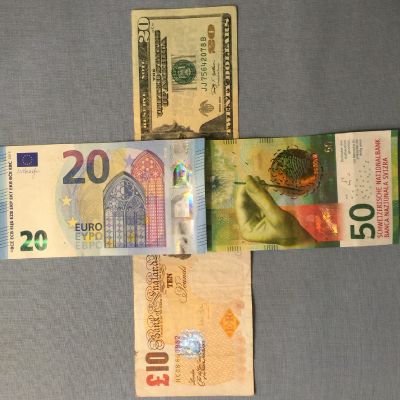Personal Wealth Management / Economics
A Whole Latte Nonsense About the Dollar
Coffee is one of the most useful substances on earth, but it is not a gauge of currency values.
Which one of these is overvalued? Photo by Elisabeth Dellinger.
Did you hear? The US dollar is simultaneously “11% overvalued” and “5% undervalued.” Weird, right? Well those are the competing conclusions of just two of the many, many outfits spending time trying to calculate whether the dollar is too high, too low or just right. It is largely a fruitless effort: In currencies, there is no such thing as some inherent fair value. The value of a free-floating currency, always and everywhere, is what the market says it is.
Thursday’s online edition of The Wall Street Journal included a rather entertaining chart showing five supranational organizations’ estimates of whether 17 major global currencies are over- or under-valued. It has us half-wondering if people forget currencies trade in pairs, with movement heavily influenced by moves in expected interest rates. Given currencies’ tendency to move with relative interest rates, is the dollar really 11% overvalued, as the Council on Foreign Relations estimates, when US interest rates are among the developed world’s highest? With most observers expecting the Fed to keep gradually hiking interest rates? Or is the market perhaps rationally pricing in those interest rate expectations?[i]
But the real fun comes later on, when the article compares the price of a tall latte from Starbucks in 29 countries (24 currencies) as an alternate way of measuring which countries are overvalued versus the dollar and which are undervalued. As the Journal explains, this is based on a concept called purchasing-power parity, which is widely used in academics to compare economies at different stages of development. The IMF regularly adjusts for purchasing-power parity in order to (bizarrely) argue that China’s $11 trillion economy is larger than America’s $19 trillion GDP.[ii] Hey, to each their own.
The Journal’s latte chart shows coffee being priciest in Zurich, where a tall latte costs $5.76, and cheapest in Cairo at $1.53—the implication being the dollar is severely overvalued in Switzerland and undervalued in Egypt. But does that really make the dollar grossly undervalued in Egypt? Or does it mean Starbucks has rationally lowered prices there, in a less developed country with some pretty glaring political issues, in order to maintain demand? Perhaps Starbucks is able to charge lower prices there since overhead is lower. So many factors beyond relative currency values influence prices. Don’t forget basic Econ 101: Price is a function of supply and demand in the end market. If it were otherwise, the price of Japanese tea at my local Japanese market would have plunged when the yen weakened in 2013. It didn’t.
The Journal acknowledges this, pointing out that “factors such as country taxes” can influence prices. But so can a host of other prices. Such as: What is the competition charging? What does Starbucks need to do in order to have a big market share? How much flexibility do they have on the cost side? How expensive is real estate, labor and equipment, all of which can influence supply? Yes, lattes are expensive in Switzerland, but as I discovered while on holiday there visiting friends last year, everything is stupid-expensive in Switzerland. Plus! Theoretically, the strong franc should make imports, like coffee, cheaper. So based on currency logic, shouldn’t lattes be cheaper in Zurich and Geneva?
Perhaps most amusingly, the chart shows a latte costing $4.21 in Brussels, $3.41 in Berlin and $3.09 in Athens. Sooooo … is the dollar simultaneously overvalued in Belgium, at fair-ish value in Germany and undervalued in Greece? And before you answer, may I remind you that all use the same currency? (Which happens to be trading at $1.16 at the moment?[iii]) Currency swings simply cannot explain differences in latte prices around the eurozone. Only supply and demand can.
Look, I don’t mean to poke fun at the Journal. The article in question is actually highly useful, as it is a timely reminder that opinions about currency valuations can be all over the map—and all estimates and analysis are solely opinions. Not facts. Not predictive. Not meaningful to stocks, which largely don’t care about currency values anyway. For stock investors, efforts to measure and predict the dollar are beside the point.
If you would like to contact the editors responsible for this article, please message MarketMinder directly.
*The content contained in this article represents only the opinions and viewpoints of the Fisher Investments editorial staff.
Get a weekly roundup of our market insights
Sign up for our weekly e-mail newsletter.

You Imagine Your Future. We Help You Get There.
Are you ready to start your journey to a better financial future?

Where Might the Market Go Next?
Confidently tackle the market’s ups and downs with independent research and analysis that tells you where we think stocks are headed—and why.






